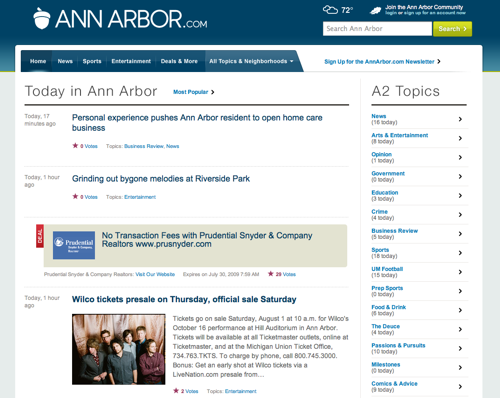
The first thing I noticed on AnnArbor.com is, well, the first thing I was supposed to notice. The bare home page doesn’t even try to do the traditional newspaper editor’s job of defining which stories are the most important or pressing. It’s simply a time-sequenced river of news. Think of it as Times Wire, except without the choice to click back to The New York Times’ spiffy home page. This is the home page.
It might not be what readers expected when Tony Dearing, AnnArbor.com’s chief content officer, promised a site “different from anything you’ve ever seen,” but maybe it should have been. “Somehow, that has the connotation of this fantastic, super-futuristic, dancing-women, fireworks-going-off site,” Dearing told me. “And really, I meant it in the opposite way. It’s going to be very different, but in a simple, understated way that news sites traditionally have not gone.”
Indeed, AnnArbor.com — which launched the day after The Ann Arbor News shuttered — looks more like Digg and Twitter than it does the Detroit Free Press. At least right now, an investigative enterprise story is featured no more prominently than a 200-word blog post. Everything — design, content, even advertising — is different.
That’s the point. “At a lot of other newspaper Web sites, people come, stop by, check in and then glance off,” said Hassan Hodges, the site’s director of technology. “They check in maybe once a day for occasional use. We’re trying to encourage much more frequent and engaged usage.”
The river of news
That unique appeal starts with the unconventional home page, organized by time and not importance. For most stories, all readers see is the timestamp, headline, votes, comments, categorized topics and a photo, if there is one.
The main limitation of such a format are obvious: namely, that a big story can be washed away by a torrent of small ones. It’s a concern, but Dearing said that the quick push to launch has kept some layout features from being ready. Soon, the homepage will have the ability to become more flexible — more newspaper-like, in a way — if a story merits the attention.
Still, AnnArbor.com doesn’t aspire to be a mainstream media Web site. “In addition to covering news and being a journalistic source, our goal was to be a true community hub,” Dearing said. “Taking a very traditional, hierarchical, top-headlines-of-the-day approach did not feel like it was going to really give people that feel or the breadth of what the site seeks to do, which is reflect the entire community and not just the news. The river of news is the direction things are headed in. It’s clear people are getting more comfortable with that.”
Finding a voice
The site boasts 35 trained journalists, who cover everything from local government to University of Michigan football. The stories seem short for now, but that’s not a conscious editorial strategy. “I think we’re finding our voice,” Dearing said. “No reporter’s being told, ‘Don’t write more than 200 words,’ or anything like that. They write what they need to say to tell a story.”
The neighborhood-level reporting is currently focused on a few locations: downtown Ann Arbor, plus Burns Park and Old West . Coverage of other neighborhoods is provided by an Outside.in feed. (“Again, not a perfect solution, but a small start,” Dearing wrote in a blog post announcing the strategy.) He hopes the experiment produces a model for hyperlocal reporting that can be applied to other areas, starting in around six months.
But stories from reporters are interspersed with dispatches from local bloggers — who may not know AP style, but who are hopefully fluent in their niches of expertise. Their blog posts currently look the same as, say, a breaking news story, but there will soon be visual differentiation between staff-generated journalism and citizen journalism, Dearing said.

Advertisements already have a distinct visual appearance in the news feed. The ads are billed as “deals,” and they are sortable by category on a specific advertising page. Two advertisements pop up in the current nine-story river of news on the front page, with six more under a tab lower on the page. On individual article pages, the deals have prominent displays in sidebars.
The advertising is extremely local and, compared to newspapers, extremely cheap, said Dearing, who noted that it’s still too early to translate early enthusiasm from advertisers into quantifiable revenue.
Future in the community
Despite the highly-public nature of its launch, AnnArbor.com is not a finished product. It will look different in a month than it does now, in part because of the restraints of a forced launch date. And it will certainly look different in a year based on community feedback. Journalism observers have been quick to offer their two cents — Dearing sees insiders’ reactions split 50/50, based on utility and aesthetics — but Dearing said “most people who have come to the site haven’t reacted. They’ve just used it.”
In the meantime, as more of Ann Arbor’s Internet-savvy demographic bookmarks AnnArbor.com, changes wait to be rolled out. There will be more photos, more video, a more evenly-distributed advertising model, and even a potential content-sharing partnership with the Michigan Daily. “This is very much defined by the community,” Dearing said. “We are going to be what the community wants us to be.”